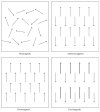Perspective of Fe3O4 Nanoparticles Role in Biomedical Applications
- PMID: 27293893
- PMCID: PMC4884576
- DOI: 10.1155/2016/7840161
Perspective of Fe3O4 Nanoparticles Role in Biomedical Applications
Abstract
In recent years, although many review articles have been presented about bioapplications of magnetic nanoparticles by some research groups with different expertise such as chemistry, biology, medicine, pharmacology, and materials science and engineering, the majority of these reviews are insufficiently comprehensive in all related topics like magnetic aspects of process. In the current review, it is attempted to carry out the inclusive surveys on importance of magnetic nanoparticles and especially magnetite ones and their required conditions for appropriate performance in bioapplications. The main attentions of this paper are focused on magnetic features which are less considered. Accordingly, the review contains essential magnetic properties and their measurement methods, synthesis techniques, surface modification processes, and applications of magnetic nanoparticles.
Figures





















Similar articles
-
Preparation of Magnetic Nanoparticles for Biomedical Applications.Methods Mol Biol. 2017;1570:73-89. doi: 10.1007/978-1-4939-6840-4_5. Methods Mol Biol. 2017. PMID: 28238130
-
Nanozymes: Biomedical Applications of Enzymatic Fe3O4 Nanoparticles from In Vitro to In Vivo.Adv Exp Med Biol. 2019;1174:291-312. doi: 10.1007/978-981-13-9791-2_9. Adv Exp Med Biol. 2019. PMID: 31713203 Review.
-
Photo-fluorescent and magnetic properties of iron oxide nanoparticles for biomedical applications.Nanoscale. 2015 May 14;7(18):8209-32. doi: 10.1039/c5nr01538c. Nanoscale. 2015. PMID: 25899408 Review.
-
pH-responsive poly(aspartic acid) hydrogel-coated magnetite nanoparticles for biomedical applications.Mater Sci Eng C Mater Biol Appl. 2017 Aug 1;77:366-373. doi: 10.1016/j.msec.2017.03.244. Epub 2017 Mar 29. Mater Sci Eng C Mater Biol Appl. 2017. PMID: 28532042
-
A universal magnetic ferrofluid: Nanomagnetite stable hydrosol with no added dispersants and at neutral pH.J Colloid Interface Sci. 2016 Apr 15;468:307-312. doi: 10.1016/j.jcis.2016.01.061. Epub 2016 Jan 28. J Colloid Interface Sci. 2016. PMID: 26852355
Cited by
-
Experimental challenges regarding the in vitro investigation of the nanoparticle-biocorona in disease states.Toxicol In Vitro. 2018 Sep;51:40-49. doi: 10.1016/j.tiv.2018.05.003. Epub 2018 May 5. Toxicol In Vitro. 2018. PMID: 29738787 Free PMC article.
-
Molecular Docking Approach for Biological Interaction of Green Synthesized Nanoparticles.Molecules. 2024 May 21;29(11):2428. doi: 10.3390/molecules29112428. Molecules. 2024. PMID: 38893302 Free PMC article. Review.
-
A Study of Hyaluronic Acid's Theoretical Reactivity and of Magnetic Nanoparticles Capped with Hyaluronic Acid.Materials (Basel). 2024 Mar 7;17(6):1229. doi: 10.3390/ma17061229. Materials (Basel). 2024. PMID: 38541384 Free PMC article.
-
Fe3O4 coated stent prevent artery neointimal hyperplasia by inhibiting vascular smooth muscle cell proliferation.Mater Today Bio. 2024 Jun 20;27:101133. doi: 10.1016/j.mtbio.2024.101133. eCollection 2024 Aug. Mater Today Bio. 2024. PMID: 39027680 Free PMC article.
-
Modification of Magnetite Nanoparticles with Triazine-Based Dendrons and Their Application as Drug-Transporting Systems.Int J Mol Sci. 2021 Oct 21;22(21):11353. doi: 10.3390/ijms222111353. Int J Mol Sci. 2021. PMID: 34768784 Free PMC article.
References
-
- Sharifi I., Shokrollahi H. Structural, magnetic and Mössbauer evaluation of Mn substituted Co-Zn ferrite nanoparticles synthesized by co-precipitation. Journal of Magnetism and Magnetic Materials. 2013;334:36–40. doi: 10.1016/j.jmmm.2013.01.021. - DOI
-
- Sharifi I., Shokrollahi H., Doroodmand M. M., Safi R. Magnetic and structural studies on CoFe2O4 nanoparticles synthesized by co-precipitation, normal micelles and reverse micelles methods. Journal of Magnetism and Magnetic Materials. 2012;324(10):1854–1861. doi: 10.1016/j.jmmm.2012.01.015. - DOI
-
- Teja A. S., Koh P.-Y. Synthesis, properties, and applications of magnetic iron oxide nanoparticles. Progress in Crystal Growth and Characterization of Materials. 2009;55(1-2):22–45. doi: 10.1016/j.pcrysgrow.2008.08.003. - DOI
-
- Majewski P., Thierry B. Functionalized magnetite nanoparticles—synthesis, properties, and bio-applications. Critical Reviews in Solid State and Materials Sciences. 2007;32(3-4):203–215. doi: 10.1080/10408430701776680. - DOI
Publication types
LinkOut - more resources
Full Text Sources
Other Literature Sources

